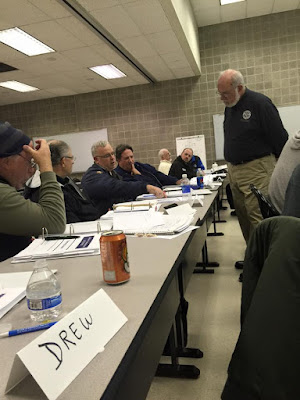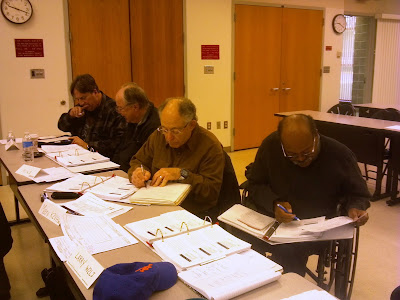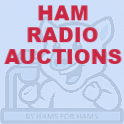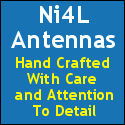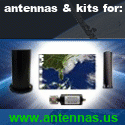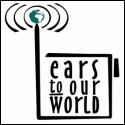Archive for the ‘skywarn’ Category
 Livestream: Space WX, Propagation, Amateur Radio – Sundays
Livestream: Space WX, Propagation, Amateur Radio – Sundays
 Exploring Shortwave Radio Signals: A Peek into Non-Local Communications
Exploring Shortwave Radio Signals: A Peek into Non-Local Communications
Curious about what you can hear on shortwave ham radio? This video is a brief survey of the diverse world of communications on the shortwave spectrum. Expand your radio horizons and enhance your emergency communication preparedness by tuning in to the world of shortwave ham radio.
If you’ve started delving into radio communications beyond local stations and channels, like VHF and UHF, you’re in for a treat. Shortwave radio opens up a whole new realm of signals to explore, including emergency communications vital during natural disasters.
Shortwave radio covers a range of radio frequencies from 3 kHz to 30 MHz. This spectrum is home to a diverse array of radio signals that cater to various communication needs, making it a hub of activity and connectivity.
Within these high frequencies, you can tune in to a multitude of transmissions, from transoceanic air traffic control communications to the chatter of ships navigating the vast seas. Imagine hearing the voices of fishermen, much like those on your favorite reality TV shows about high-seas fishing adventures, along with military communications and the vibrant world of amateur radio enthusiasts.
One of the remarkable features of high-frequency (HF) radio is its ability to propagate signals over long distances, transcending line-of-sight limitations. This means that HF radio enables communication between different regions and even continents, fostering connectivity across vast distances.
During times of crisis and natural disasters, shortwave frequencies become invaluable for emergency communications. When local infrastructure falters or is disrupted, shortwave radio serves as a vital lifeline, facilitating critical two-way communications in and out of disaster-stricken areas.
Explore the fascinating realm of shortwave radio, where distant voices blend with essential information, bridging gaps and connecting communities in times of need. Uncover the power of HF radio to transcend boundaries and provide lifelines when they are needed most.
In this video, I give you a glimpse of the voice and data transmissions I pick up on my high-frequency amateur radio transceiver (in this video, an Icom IC-7000). In later videos, I will dive deeper into specific types of HF communications, such as aeronautical trans-oceanic signals.
 German Teletype (RTTY) Weather on HF (Shortwave) Radio
German Teletype (RTTY) Weather on HF (Shortwave) Radio
This is a video of the German Weather Broadcast from DWD, Hamburg, on shortwave (HF), using teletype (RTTY). I demonstrate two decoding software options: JWcomm32 (older), and, FLdigi. Note the in FLdigi, the “Reverse” feather is selected to properly decode the signal (in either USB or LSB, you still need to select, “Reverse”).
The radio used to receive these weather bulletins is an Icom IC-7610, using an antenna designed for 160 Meters.
RTTY is a system for broadcasting text over radio. The technology dates back to the late 1950s and seems somewhat anachronistic. Speeds are slow, even slower than NAVTEX. A similar service is the USCG service, SITOR (Simplex Teletype Over Radio) providing offshore and coastal forecasts over very wide and remote areas from the tropics to the polar regions.
There is dedicated equipment to receive RTTY and SITOR but we can receive both using a standard HF/SSB receiver with software packages such as TRUETTY and SEATTY to decode the signals.
The main advantage of RTTY/SITOR is the reception of information over an entire ocean area. The USCG also shares frequencies across multiple transmitters according to a schedule, rather like NAVTEX. The system is available over the Atlantic and Pacific including polar regions not served. For more about SITOR see the Monitoring Times link or the USCG site.
Around Western Europe and the Mediterranean, the Deutscher Wetterdienst (DWD) , the German Weather Service has accepted the responsibility to broadcast weather information for mariners on RTTY. Frequencies are in the table on the webpage at:
https://weather.mailasail.com/Franks-Weather/Radio-Teletype-Weather-Broadcasts
This video captures the RTTY transmission on 14467.3 kHz (with adjustment in the passband to center on Mark and Space as seen in the video).
DWD (Hamburg) Broadcast Content:
Some broadcasts are of raw weather observations in a WMO coded form. Otherwise, for the broadcasts include,
- Strong wind, gale and storm warnings for German Bight, Western and Southern Baltic Sea, German North Sea and Baltic Sea coast
- Weather forecast for the North Sea and Baltic Sea, Weather situation, forecast valid for 12 hours and outlook valid for another 12 hours
- Weather report German North Sea and Baltic Sea coast, Weather situation and forecast valid for 12 hours.
- Navigational warnings for North Sea, Baltic Sea and German coast
- Weather report Norwegian Sea and Baltic Sea Route North Cape – Shetlands, The Quark – Gulf of Finland. Weather situation and time series forecast for 2 days
- Weather report North Atlantic. Route Pentlands – Southwest Greenland. Weather situation and time series forecast for 2 days
- Station reports North Sea and Baltic Sea
- Weather report Western European Sea. Route Southern Ireland – Area Canarias. Weather situation and time series forecast for 2 days
- Medium range weather report North Sea, Weather situation and time series forecast for 5 days
- For the Mediterranean there are Station reports Mediterranean Sea
- Weather report Mediterranean Sea (in German), Weather situation and forecast valid for 24 hours.
- Alborán – Tunis. Weather situation and time series forecast for 2 days
- Weather report Eastern Mediterranean Sea (in German). Route Eastern Tunis – Rhodes/Cyprus. Weather situation and time series forecast for 2 days
- Medium range weather report Mediterranean Sea (in English), Weather situation and time series forecast for 5 days
- Around the North Sea and the Baltic this service is a useful supplement to NAVTEX. Particularly so are the 5 day outlooks, These give wind forecast every 12 hours for the 5 day period. The values are straight from the DWD NWP model at a few grid points although these are sufficient to give an overall view and much quicker to receive than synoptic charts on radio fax.
In the Mediterranean, most valuable is the 5 day forecast which seems to be used and very highly regarded by the majority of serious cruising yachtsmen. It is a most valuable service for predicting the major strong wind systems such as Mistrals, Libeccios, Tramontanes, etc. Such winds are usually well predicted 4 and often 5 days ahead. Conversely, I have never found the 24 hour forecast to be much use. For this period, the French, Spanish and even the Italian NAVTEX broadcasts are to be preferred.
 Modern Amateur Radio Hobby – An Introduction
Modern Amateur Radio Hobby – An Introduction
This video is an introduction to an international public-service and technology hobby known as ‘amateur radio’ (or ‘ham radio’).
Amateur radio (also called ham radio) describes the use of radio frequency spectrum for purposes of non-commercial exchange of messages, wireless experimentation, self-training, private recreation, radiosport, contesting, and emergency communication. The term “amateur” is used to specify “a duly-authorized person interested in radioelectric practice with a purely personal aim and without pecuniary interest;” (either direct monetary or other similar rewards) and to differentiate it from commercial broadcasting, public safety (such as police and fire), or professional two-way radio services (such as maritime, aviation, taxis, etc.).
The amateur radio service (amateur service and amateur-satellite service) is established by the International Telecommunication Union (ITU) through the Radio Regulations. National governments regulate technical and operational characteristics of transmissions and issue individual stations licenses with an identifying call sign. Prospective amateur operators are tested for their understanding of key concepts in electronics and the host government’s radio regulations. Radio amateurs use a variety of voice, text, image, and data communications modes and have access to frequency allocations throughout the RF spectrum to enable communication across a city, region, country, continent, the world, or even into space.
Amateur radio is officially represented and coordinated by the International Amateur Radio Union (IARU), which is organized in three regions and has as its members the national amateur radio societies which exist in most countries. According to an estimate made in 2011 by the American Radio Relay League, two million people throughout the world are regularly involved with amateur radio. About 830,000 amateur radio stations are located in IARU Region 2 (the Americas) followed by IARU Region 3 (South and East Asia and the Pacific Ocean) with about 750,000 stations. A significantly smaller number, about 400,000, are located in IARU Region 1 (Europe, Middle East, CIS, Africa).
Activities and practices
The expansive diversity found in the amateur radio hobby attracts practitioners who have a wide range of interests. Many hams begin with a fascination of radio communication and then combine other personal interests to make the pursuit of the hobby rewarding. Some of the focal areas amateurs pursue include radio contesting, radio propagation study, public service communication, technical experimentation, and computer networking. But, that is just a sampling of interest areas found in the hobby.
Amateur radio operators use various modes of transmission to communicate. The two most common modes for voice transmissions are frequency modulation (FM) and single sideband (SSB). The FM mode offers high-quality audio signals, while SSB is better at long distance communication when bandwidth is restricted.
Modern personal computers have encouraged the use of digital modes such as radioteletype (RTTY) which previously required cumbersome mechanical equipment. Hams led the development of packet radio in the 1970s, which has employed protocols such as AX.25 and TCP/IP. Specialized digital modes such as PSK31 allow real-time, low-power communications on the shortwave bands. More robust digital modes have been invented and improved, including such modes as Olivia, JT65, and WSPR.
NASA astronaut Col. Doug Wheelock, KF5BOC, Expedition 24 flight engineer, operates the NA1SS ham radio station in the Zvezda Service Module of the International Space Station. Equipment is a Kenwood TM-D700E transceiver.
Amateur radio operators, using battery- or generator-powered equipment, often provide essential communications services when regular channels are unavailable due to natural disasters or other disruptive events.
This video comes to us via Canada, and is used by permission from Bernard Bouchard – / ve2sms – The original video was published on Feb 28, 2013.- Website is https://www.ve2cwq.ca/amateur-radio-club-ve2cwq/
Voici maintenant, la version complète du documentaire «La radioamateur» d’une durée de 11 minutes. On y aborde toutes les activités sur le monde de la radioamateur. Ce vidéo a été produit par le Club Radioamateur VE2CWQ / Canwarn-Québec. Pour information: https://www.ve2cwq.ca/
Connect with me at https://NW7US.us
USA Amateur Radio information: http://ARRL.org
 Marine Radiofax Weather Charts Via Shortwave Radio – WEFAX
Marine Radiofax Weather Charts Via Shortwave Radio – WEFAX
Weather out over oceans? That, and more.
More than international broadcast stations and amateur radio operators exist on the shortwave radio spectrum. For instance, any non-broadcast signal that is not amateur radio is often lumped together into a category known as Utility Radio, abbreviated, UTE. To dig deeper into UTE activity, you could check out the UDXF – the Utility DX Forum, located here: https://www.udxf.nl/
Utility stations (UTE) are quite common, from marine (ships, fishing vessels, etc.), transoceanic air traffic (international passenger or cargo jets and other aeronautical trans-oceanic radio traffic), to military radio (weather, coordination, and much more). UTE is a rich subdomain of the radio experience.
As an amateur radio operator, I listen to and monitor utility stations on shortwave, at times when not operating as an amateur radio station. I check weather for air traffic or for marine traffic, because it helps me see the larger-scale weather patterns.
Here is a video I made of my reception of weather charts via shortwave radio from radio station NMC, at Point Reyes, CA, using FLdigi software to receive these weather fax transmissions:
WEFAX 22.527 MHz on 2024 JUNE 14
This video is a screen and sound capture of my reception of weather charts and images by shortwave radio, from a station in California running about 4 kilowatts of RF power. This HF WEFAX (Weather Facsimile) service is on every day for ship (marine) weather dissemination so that ships out on the ocean can get weather charts and images not by satellite, but by receiving shortwave signals.
Below is a snippet from the published schedule from Point Reyes WEFAX Radio, callsign NMC, as follows:
22527 kHz – tune offset 1.9 kHz (see note, below)
UTC WHICH CHART ----- -------------------------------- 19:13 TROPICAL GOES IR SATELLITE IMAGE 19:23 WIND / WAVE ANALYSIS 19:33 96HR SURFACE FORECAST 19:43 96HR WIND/WAVE FORECAST 19:53 96HR 500MB FORECAST 20:03 96HR WAVE PERIOD / DIRECTION -------------------------------------
The above snippet of the NMC chart transmission list is from the page, “NMC Point Reyes, Marine Radiofax Broadcast Schedule” found at:
https://weatherfax.com/nmc-point-reyes/
Here is a detailed description of the weather charts, and online access is at:
https://www.weather.gov/marine/radiofax_charts
Note: In the video, you see that I am tuned to 22.526 USB thus I was tuned to 22526 kHz USB, based on this: “Unless otherwise stated, assigned frequencies are shown, for carrier frequency subtract 1.9 kHz. Typically dedicated radiofax receivers use assigned frequencies, while receivers or transceivers, connected to external recorders or PC’s, are operated in the upper sideband (USB) mode using carrier frequencies.”
==================================
Source:
WORLDWIDE MARINE RADIOFACSIMILE
BROADCAST SCHEDULES
U.S. DEPARTMENT OF COMMERCE
NATIONAL OCEANIC and ATMOSPHERIC ADMINISTRATION
NATIONAL WEATHER SERVICE
April 12, 2024
https://www.weather.gov/media/marine/rfax.pdf
 ETH068 – Are You Weather Aware?
ETH068 – Are You Weather Aware?
While having access to your local RADAR wherever you are is great, you shouldn’t depend on it totally. You should be able to look at the sky, feel the wind, and see other clues to have an idea of what could be coming your way.
This brings up the question:
Are You Weather Aware?
In episode 68, we talk about this question and some things that you need to learn and do to help yourself be weather aware. Things like knowing what to look for in the clouds, why the wind suddenly changed directions, what to have in your emergency kit and having a plan with your family in case you need to vacate your home or seek shelter inside.
We dive into several weather events like tornadoes, flash floods, hail and even the event with the highest average of fatalities, which might surprise you.
We talk about W5KUB with the Amateur Radio Roundtable as he does his Hamvention coverage including the drive to and from. We also talk about some other hamfests that are coming up over the next two weeks.
If contesting is you thing, we talk about all the upcoming contests/on-the-air events for the next two weeks as well.
Check out the show notes and listen to the episode at:
 AUXCOMM
AUXCOMM
All I can say is, "Wow!". This course was fantastic and re-awakened a lot of the training that I received when I was a Communications Officer with Middlesex County OEM back in the 80s and 90s. And a lot of things have changed since then, of course, and hopefully, I absorbed them like a sponge.
The course, which spanned some 20 hours, was expertly taught by Hank Koebler N3ORX and Jim Millsap WB4NWS. If I were to go into the experience which make these two fine gentlemen qualified to teach this course, it would probably occupy the next 5-10 blog posts. Suffice it to say that we were very fortunate enough to be taught by two experts with regard to Amateur Radio and EMCOMM.
The class went by quickly, and was never boring. Jim and Hank kept it interesting and, if I may dare say, fun. The pace was quick, but with enough time given to take in all the key and necessary aspects of what was being taught. There were ten units (I hate to call them "lectures") that were broken up by plenty of exercises where we had to identify resources, come up with communications plans, and then submit them for approval. This was followed by one last "Final Exam" or final planning session which brought together everything that we had learned up to that point, In addition, throughout the class, we learned the correct procedures for filling out the necessary ICS paperwork that accompanies all these kind of events.
I must admit that after the first day, my head felt like it does after the first day of Dayton Hamvention, busting to the seams with sensory overload. But it was all good, and by the second day, I think everyone returned in the morning feeling a bit better and just a tad more comfortable with their EMCOMM skills.
The course built upon the education we received from those online FEMA courses that we all took on the Incident Command System, the National Incident Management System and the National Response Framework. It expanded upon that and throughout the class, decorum, attitude and etiquette were accented.
It does not do any good for the name and face of Amateur Radio, for uninvited, untrained, undisciplined "know-it-all cowboys" to show up to an emergency with an attitude that Amateur Radio is there "to save the day". That attitude, along with "Hey, lookie here at all my latest and greatest gear" is most assuredly going to get you escorted off the scene with a firm admonition to never return.
The keys to a successful blend of Amateur Radio and Disaster Response are training, decorum, the willingness to help with ANY situation (not just communications), and above all, professionalism. The willingness to blend in, get the job done with a minimal mount of attention or hoopla to yourself or the Amateur Radio Service, are what is needed. In fact, if you follow those guidelines, the Amateur Radio Service and Amateur Radio operators WILL come out smelling like a rose, and will be asked to come back on a continual basis.
To all Amateur Radio ops who read this blog that are interested in Public Service and Amateur Radio EMCOMM - I heartily urge you to go to your Town/City, County and State RACES/ARES leadership team to request them to have this AUXCOMM class brought to your state. Regardless of your level of experience, you are going to enjoy this class and will learn things that you never knew before.
72 de Larry W2LJ
QRP - When you care to send the very least!




